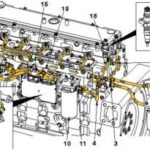If you’re a BMW owner encountering issues with your car’s locking system, you might have stumbled upon the enigmatic fault code 801C20. This code, originating from the Central Gateway Module (ZGM), signals a full fault memory without a specific control unit fault. Understanding this code and its potential causes is crucial for effective troubleshooting.
This article delves into the intricacies of Bmw Code 801c20, exploring its possible causes, outlining the necessary steps for diagnosis and repair, and providing the information you need to address this issue.
Decoding BMW Code 801C20: Causes and Implications
The 801C20 fault code specifically points to a full fault memory within the ZGM. The ZGM acts as the central communication hub for various electronic control units (ECUs) in your BMW, responsible for coordinating functions like locking, lighting, and comfort access. A full fault memory can disrupt these systems, leading to malfunctions.
One common culprit behind this error is a voltage drop during battery replacement. When the battery is disconnected or replaced improperly, the ZGM can lose its programming or accumulate errors, resulting in a saturated fault memory. This can manifest as problems with the locking system, preventing the car from locking or unlocking correctly.
Fixing BMW 801C20: Tools and Procedures
Resolving the 801C20 fault typically involves reprogramming the ZGM. This procedure requires specialized hardware and software designed to communicate with BMW’s intricate electronic systems.
Necessary Hardware:
- BMW Diagnostic Tool: A compatible diagnostic scanner, such as the BMW ICOM Next, Autel MaxiSYS Elite, or Launch X431 V+, is essential for accessing and clearing fault codes within the ZGM. This tool enables direct communication with the module.
- Laptop/PC: A computer running compatible diagnostic software is necessary to interface with the diagnostic tool and perform the reprogramming procedure.
Required Software:
- BMW Diagnostic/Programming Software: Specialized software like ISTA-D (Integrated Service Technical Application – Diagnosis), ISTA-P (Integrated Service Technical Application – Programming), or Rheingold is crucial for diagnosing the issue, clearing fault codes, and reprogramming the ZGM.
Professional Assistance Recommended
While some technically inclined individuals might attempt to tackle this issue independently, it’s strongly recommended to seek professional assistance. Reprogramming the ZGM requires specialized knowledge and tools. Incorrect procedures can potentially exacerbate the problem or damage the vehicle’s electronic systems. A qualified BMW technician possesses the expertise and equipment to diagnose and resolve the 801C20 fault code efficiently and safely. They can ensure the ZGM is correctly reprogrammed, restoring the proper functionality of your BMW’s locking system and other affected components.
Preventing 801C20: Best Practices for Battery Replacement
To minimize the risk of encountering the 801C20 error during battery replacement, adhering to best practices is crucial. Using a battery maintainer or a power supply to maintain a stable voltage during the replacement process can prevent voltage drops that disrupt the ZGM. Furthermore, ensuring proper battery registration after replacement is essential for preventing future issues.
Conclusion: Addressing BMW Code 801C20 Effectively
BMW code 801C20 signifies a full fault memory in the ZGM, often stemming from voltage fluctuations during battery replacement. Resolving this issue requires specialized diagnostic and programming tools, making professional assistance highly recommended. By understanding the cause and solution for this error, BMW owners can take proactive steps to address the problem and ensure the smooth operation of their vehicles. If you encounter this fault code, contacting a qualified BMW technician is the most effective way to diagnose and rectify the issue, restoring your vehicle’s functionality and preventing further complications.
